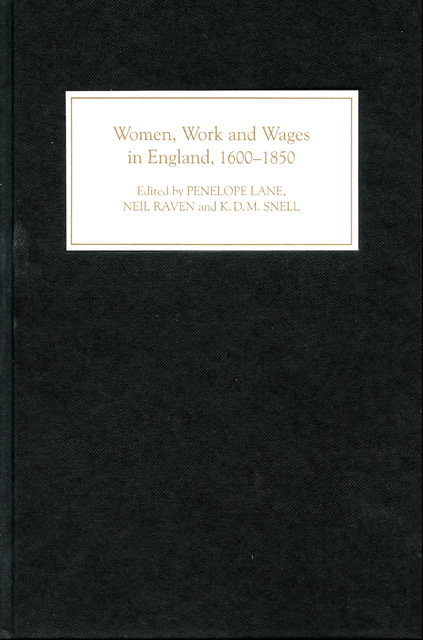Book contents
- Frontmatter
- Contents
- Illustrations
- Notes on Contributors
- Acknowledgements
- Introduction
- 1 ‘Waste’ Children? Pauper Apprenticeship Under the Elizabethan Poor Laws, c. 1598–1697
- 2 Gender at Sea: Women and the East India Company in Seventeenth-Century London
- 3 Sickles and Scythes Revisited: Harvest Work, Wages and Symbolic Meanings
- 4 A Customary or Market Wage? Women and Work in the East Midlands, c. 1700–1840
- 5 ‘Meer Pennies for My Baskitt Will be Enough’: Women, Work and Welfare, 1770–1830
- 6 Caring for the Sick Poor: Poor Law Nurses in Bedfordshire, c. 1770–1834
- 7 ‘A ‘Humbler, Industrious Class of Female’: Women’s Employment and Industry in the Small Towns of Southern England, c. 1790–1840
- 8 A Diminishing Force? Reassessing the Employment of Female Day Labourers in English Agriculture, c. 1790–1850
- Bibliography
- Index
Introduction
Published online by Cambridge University Press: 21 March 2023
- Frontmatter
- Contents
- Illustrations
- Notes on Contributors
- Acknowledgements
- Introduction
- 1 ‘Waste’ Children? Pauper Apprenticeship Under the Elizabethan Poor Laws, c. 1598–1697
- 2 Gender at Sea: Women and the East India Company in Seventeenth-Century London
- 3 Sickles and Scythes Revisited: Harvest Work, Wages and Symbolic Meanings
- 4 A Customary or Market Wage? Women and Work in the East Midlands, c. 1700–1840
- 5 ‘Meer Pennies for My Baskitt Will be Enough’: Women, Work and Welfare, 1770–1830
- 6 Caring for the Sick Poor: Poor Law Nurses in Bedfordshire, c. 1770–1834
- 7 ‘A ‘Humbler, Industrious Class of Female’: Women’s Employment and Industry in the Small Towns of Southern England, c. 1790–1840
- 8 A Diminishing Force? Reassessing the Employment of Female Day Labourers in English Agriculture, c. 1790–1850
- Bibliography
- Index
Summary
Women’s history has been one of the growth areas of historical enquiry over the past three decades. Inspired by the women’s movement, as well as by interest in the history of the family, historical demography and community history, the subject has come a long way from the writings of earlier scholars such as Alice Clark and Ivy Pinchbeck. It has diversified rapidly, incorporating all academic disciplines, building up much more complex theoretical perspectives, becoming highly international and comparative in scope, and starting to bring nuanced and discerning knowledge at the local or regional level. Its relevance to countless other fields of historical enquiry is now widely accepted. Women’s history has also become increasingly resourceful in its approaches, its methods and its handling of diverse sources. It has seen the inauguration of its own scholarly journals, study centres, archives and websites, has had many valuable regional museum displays dedicated to it, and has become a mainstay of teaching and research at all educational and academic levels. We now know infinitely more about women’s experiences in the past than we did thirty years ago, and this historical knowledge informs current social and political debates, ideologies and policy proposals in persistent and pervasive ways.
Yet many of the debates that emerged in the early twentieth century, when Pinchbeck and Clark were writing, remain unresolved. In the British contexts, there is still disagreement over whether female participation in ‘the workforce’ (however defined) expanded or diminished during the Industrial Revolution. We do not know enough about locally specific rates and forms of remuneration accorded to women, or about the seasonal or cyclical nature of their work, or about how many hours they worked. Accordingly, major debates on issues such as how the standard of living altered during industrialisation, or the gendered nature of the home market, or the reasons for important nuptiality and fertility changes in English demography, have proceeded with meagre knowledge of women’s employment, wages and living standards. Arguments about ‘patriarchy’, or changing gender standards, often still take place in swirling waters which lack the stepping-stones that understanding of the past could provide. Furthermore, we have little information about how women’s time was spent over the gamut of their routines both within and outside the familial household. Gendered time schedules, their causes and their relative rewards, remain little fathomed.
- Type
- Chapter
- Information
- Women, Work and Wages in England, 1600-1850 , pp. 1 - 14Publisher: Boydell & BrewerPrint publication year: 2004



